Florida’s climate throws a medley of challenges at homeowners, from scorching sunbeams and howling hurricanes to stealthy salt air—all of which conspire to test the mettle of your rooftop.
Understanding Florida’s Unique Roofing Needs
Florida’s climate presents a gauntlet of challenges for roofing materials. The state’s signature high humidity can foster mold and mildew, leading to deterioration if the material isn’t moisture-resistant.
Heavy rainfall, especially during hurricane season, demands robust waterproofing and efficient drainage to keep leaks at bay. Speaking of hurricanes, the high winds and flying debris associated with these storms necessitate a roofing material that stands firm against nature’s fury.
Lastly, the intense heat of Florida’s summers can hike up energy costs, making it essential to choose a material that reflects heat effectively. Selecting a roof that can weather these elements is paramount for the longevity and protection of Florida homes.
Types of Roofing Materials Available in Florida
When the Florida sun plays peek-a-boo with storm clouds, homeowners need roofing that can laugh in the face of tempestuous weather. From the classic asphalt shingles to the sturdy metal roofs, there’s a veritable buffet of roofing materials each with its own flavor of pros and cons.
Asphalt shingles, for instance, are the quintessential American roof topping. They’re as affordable as a beachside hotdog and can be fixed up by any DIY enthusiast. However, they might throw in the towel when faced with a hurricane’s uppercut.
Then there’s the heavyweight champion, concrete tiles, whose durability makes them a knockout choice for longevity. But, they come with the need for a strong structural support system, thanks to their Atlas-esque weight.
Up next are the clay tiles, radiating Spanish charm and boasting a resistance to rot and insect damage that’s as impressive as Florida’s coastline. Yet, they’re as fragile as a sandcastle at high tide when it comes to impact.
For those who prefer their homes to reflect more than just style, metal roofing is the silver bullet. It’s a fortress against the elements, reflecting sunlight with the grace of a disco ball and standing strong in the face of gale-force winds. However, if it does get dented, it might call for a full roof rendition.
Lastly, composite tiles offer a low-maintenance utopia and come with a warranty that’s longer than a Florida summer, making them an increasingly popular choice.
Each material has its own unique charms and challenges, and Floridians would do well to choose based on the rhythm of their local climate dance.
Hurricane-Proof Roofing Options
In the Sunshine State, where hurricanes are as common as the orange groves, a roof is more than just a shelter—it’s a shield. Choosing the right hurricane-proof roofing material is not just a matter of curb appeal; it’s about survival.
With winds that can turn everyday objects into projectiles, materials like metal roofing, known for withstanding gusts up to 160 mph, and ceramic tiles, which can endure over 100 mph winds, rise above the rest in terms of resilience and durability.
But muscle alone doesn’t cut it; brains—in the form of compliance with building codes—are equally important. In Florida’s high-wind zones, regulations mandate features like impact-resistant windows and reinforced doors.
To ensure your roof adheres to these standards, it’s not just about picking the toughest material but also integrating essential reinforcements such as roof straps that anchor your home from top to bottom, as required by the Florida Building Codes.
When the skies darken and the winds howl, a well-chosen, compliant roof can make the difference between weathering the storm and becoming a footnote in its history.
Materials That Can Withstand Extreme Heat and Humidity
Florida’s climate is like a double-edged sword; it offers abundant sunshine but also subjects homes to extreme heat and humidity. This combination can wreak havoc on roofing materials, leading to premature deterioration, mold growth, and energy inefficiency.
To combat these challenges, homeowners should consider materials like metal roofing, which reflects solar radiation and resists corrosion. Tile roofing, including both clay and concrete options, offers a blend of durability and natural insulation properties.
For those seeking energy efficiency, asphalt shingles with a reflective coating or single-ply roofing membranes like PVC and TPO can reflect sunlight to keep homes cooler.
Meanwhile, the timeless elegance of slate roofing brings natural heat resistance and longevity despite its higher cost.
To maximize the lifespan of these materials in Florida’s demanding climate, regular maintenance is key. Inspections for damage, proper ventilation, and timely repairs can prolong the life of a roof.
Moreover, choosing materials with built-in resistance to UV rays and moisture will ensure that Florida homes remain both beautiful and resilient in the face of sweltering summers and stormy weather.
Choosing the Right Roofing Material for Your Home
When it comes to sheltering your Florida home from the sun’s sizzle and the storm’s fury, the right roof isn’t just an option—it’s a necessity.
While the allure of metal roofing with its 40-70 year lifespan and cool reflective surface may tempt you, remember that it comes with a higher upfront cost.
On the other hand, the classic asphalt shingle is kinder to your wallet but may flirt with frequent repairs.
Here’s a quick rundown to help you pick your champion:
- Asphalt Shingles: A cost-efficient choice that offers a decent range of styles. Great for budget-minded homeowners who prioritize affordability over fancy features.
- Tile Roofing: A heavyweight contender, it boasts superior insulation and a rainbow of finishes, perfect for those seeking a touch of Spanish flair. However, keep in mind its susceptibility to breakage and higher installation costs.
- Metal Roofing: Durable and energy-efficient, this material is a guardian against UV rays and wind. Ideal for homeowners who prioritize longevity and energy savings, but be prepared for a slightly higher price tag and the possibility of rain noise.
When selecting the perfect cover for your abode, consider the architectural style of your home—will your roof be a harmonious hat or a mismatched toupee? Imagine a quaint beach bungalow sporting a sleek metal roof? Not quite the looker, is it?
Conversely, a modern mansion with traditional asphalt shingles might appear a bit out of place. The best material for your home depends on a balance of these factors, tailored to your personal and home’s character.
Seek the guidance of a seasoned roofing contractor to ensure your choice not only looks good but stands up to Florida’s feisty weather.
Financing Your Roof Replacement Project
Replacing a roof is a significant investment, and understanding financing options can make a big difference. Here are some ways Florida homeowners can manage the cost:
- Cash Payment: This offers the most leverage when negotiating with contractors. If you have the funds readily available, this can be a great way to save on interest.
- Home Improvement Loans: Several lenders provide unsecured loans specifically for home renovations, often with competitive interest rates and repayment terms. This can be a good option if you don’t want to dip into your savings.
- FHA 203(k) Rehabilitation Loan: This federally backed loan allows homeowners to finance both the purchase and installation of a new roof, along with other necessary repairs. This can be a good option for larger projects that include other renovations.
- PACE Financing: This government-backed program offers special financing for energy-efficient improvements, including certain types of roofs. Be sure to understand the repayment structure and potential tax implications before opting for PACE financing.
Hiring a Reputable Roofing Contractor
Selecting a qualified contractor is critical for a successful roof replacement. Here are some tips to help you find the right one:
- Get Multiple Quotes: Obtain estimates from at least three licensed and insured contractors. Don’t be afraid to shop around to get the best price and service.
- Check Credentials: Verify that the contractor holds a valid state license and carries proper insurance coverage, including worker’s compensation and liability insurance. This will protect you in case of any accidents or mishaps during the project.
- Request References: Contact past clients to get a sense of the contractor’s work ethic, quality, and communication style. Talking to people who have used the contractor before can give you valuable insights.
- Ask About Warranties: Ensure the contractor offers a workmanship warranty on the installation, in addition to the material warranty provided by the manufacturer. A good warranty will give you peace of mind knowing that the contractor will fix any problems that arise from their work.
- Read the Fine Print: Before signing any contract, thoroughly review the terms, payment schedule, and project timeline. Make sure you understand all the details of the agreement before committing.
Parting Words
Florida homeowners, due to the unique and often challenging weather patterns of the region, must take several important steps to ensure the longevity and protection of their homes.
Understanding the various financing options available to them is the first crucial step. This involves a deep dive into different loan possibilities, their terms, interest rates, and how they fit with the homeowner’s financial situation.
Secondly, conducting thorough research on potential contractors is necessary.
Homeowners should look into each contractor’s reputation, work history, and customer reviews. It’s also important to ensure they are licensed, insured, and have experience with local building codes and weather conditions.
Lastly, choosing the right roofing material is vital. There are numerous options available, each with its own advantages and disadvantages. Factors to consider include durability, cost, aesthetics, and how well the material can withstand Florida’s unique climate.
By taking these steps, homeowners in Florida can effectively protect their homes from the region’s weather challenges, ensuring the structure’s durability and integrity for many years to come.






